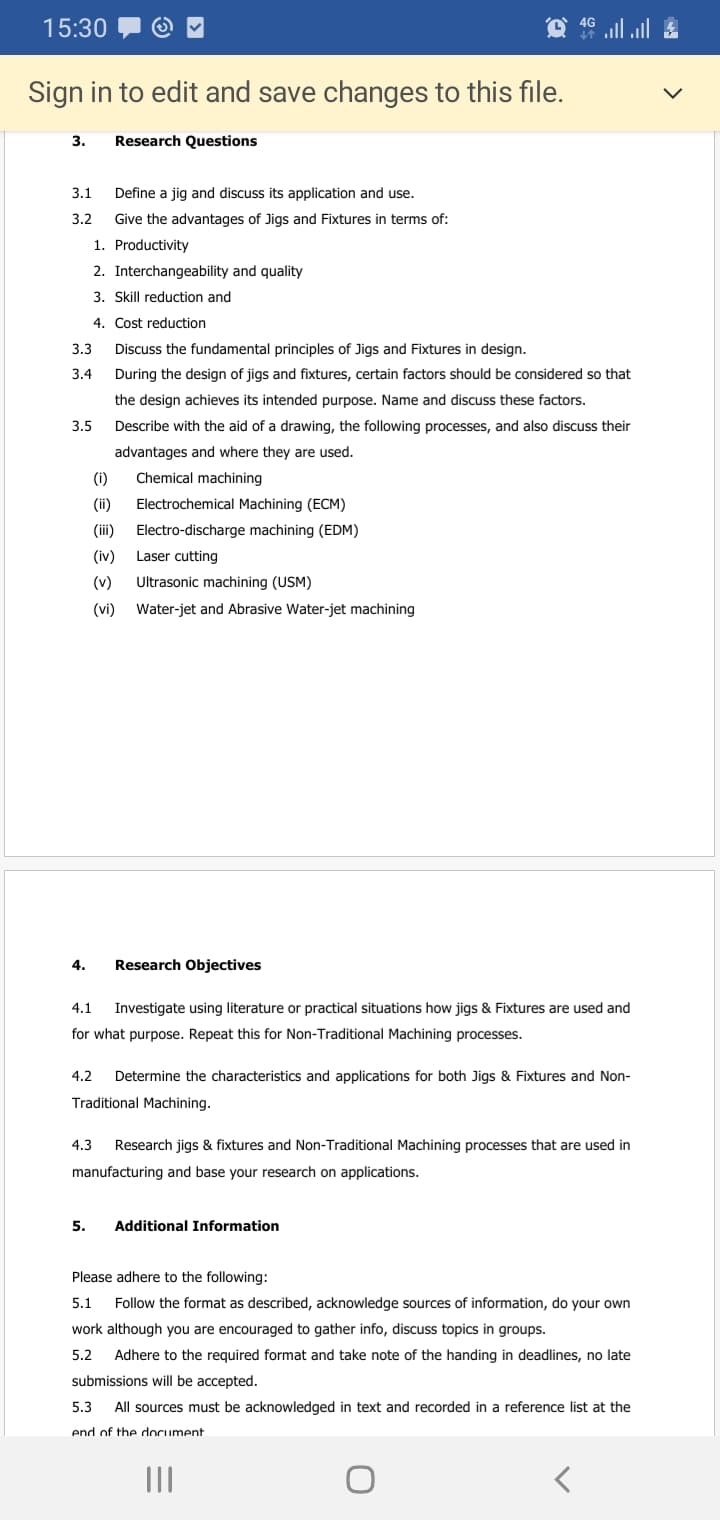3.1 Define a jig and discuss its application and use. 3.2 Give the advantages of Jigs and Fixtures in terms of: 1. Productivity 2. Interchangeability and quality 3. Skill reduction and 4. Cost reduction 3.3 Discuss the fundamental principles of Jigs and Fixtures in design.
3.1 Define a jig and discuss its application and use. 3.2 Give the advantages of Jigs and Fixtures in terms of: 1. Productivity 2. Interchangeability and quality 3. Skill reduction and 4. Cost reduction 3.3 Discuss the fundamental principles of Jigs and Fixtures in design.
Elements Of Electromagnetics
7th Edition
ISBN:9780190698614
Author:Sadiku, Matthew N. O.
Publisher:Sadiku, Matthew N. O.
ChapterMA: Math Assessment
Section: Chapter Questions
Problem 1.1MA
Related questions
Question

Transcribed Image Text:15:30
ull l
Sign in to edit and save changes to this file.
3.
Research Questions
3.1
Define a jig and discuss its application and use.
3.2
Give the advantages of Jigs and Fixtures in terms of:
1. Productivity
2. Interchangeability and quality
3. Skill reduction and
4. Cost reduction
3.3
Discuss the fundamental principles of Jigs and Fixtures in design.
3.4
During the design of jigs and fixtures, certain factors should be considered so that
the design achieves its intended purpose. Name and discuss these factors.
3.5
Describe with the aid of a drawing, the following processes, and also discuss their
advantages and where they are used.
(i)
Chemical machining
(ii)
Electrochemical Machining (ECM)
(iii)
Electro-discharge machining (EDM)
(iv)
Laser cutting
(v)
Ultrasonic machining (USM)
(vi)
Water-jet and Abrasive Water-jet machining
4.
Research Objectives
4.1
Investigate using literature or practical situations how jigs & Fixtures are used and
for what purpose. Repeat this for Non-Traditional Machining processes.
4.2
Determine the characteristics and applications for both Jigs & Fixtures and Non-
Traditional Machining.
4.3
Research jigs & fixtures and Non-Traditional Machining processes that are used in
manufacturing and base your research on applications.
5.
Additional Information
Please adhere to the following:
5.1
Follow the format as described, acknowledge sources of information, do your own
work although you are encouraged to gather info, discuss topics in groups.
5.2
Adhere to the required format and take note of the handing in deadlines, no late
submissions will be accepted.
5.3
All sources must be acknowledged in text and recorded in a reference list at the
end of the dlocument
II
Expert Solution
This question has been solved!
Explore an expertly crafted, step-by-step solution for a thorough understanding of key concepts.
This is a popular solution!
Trending now
This is a popular solution!
Step by step
Solved in 3 steps

Knowledge Booster
Learn more about
Need a deep-dive on the concept behind this application? Look no further. Learn more about this topic, mechanical-engineering and related others by exploring similar questions and additional content below.Recommended textbooks for you

Elements Of Electromagnetics
Mechanical Engineering
ISBN:
9780190698614
Author:
Sadiku, Matthew N. O.
Publisher:
Oxford University Press

Mechanics of Materials (10th Edition)
Mechanical Engineering
ISBN:
9780134319650
Author:
Russell C. Hibbeler
Publisher:
PEARSON

Thermodynamics: An Engineering Approach
Mechanical Engineering
ISBN:
9781259822674
Author:
Yunus A. Cengel Dr., Michael A. Boles
Publisher:
McGraw-Hill Education

Elements Of Electromagnetics
Mechanical Engineering
ISBN:
9780190698614
Author:
Sadiku, Matthew N. O.
Publisher:
Oxford University Press

Mechanics of Materials (10th Edition)
Mechanical Engineering
ISBN:
9780134319650
Author:
Russell C. Hibbeler
Publisher:
PEARSON

Thermodynamics: An Engineering Approach
Mechanical Engineering
ISBN:
9781259822674
Author:
Yunus A. Cengel Dr., Michael A. Boles
Publisher:
McGraw-Hill Education

Control Systems Engineering
Mechanical Engineering
ISBN:
9781118170519
Author:
Norman S. Nise
Publisher:
WILEY

Mechanics of Materials (MindTap Course List)
Mechanical Engineering
ISBN:
9781337093347
Author:
Barry J. Goodno, James M. Gere
Publisher:
Cengage Learning

Engineering Mechanics: Statics
Mechanical Engineering
ISBN:
9781118807330
Author:
James L. Meriam, L. G. Kraige, J. N. Bolton
Publisher:
WILEY